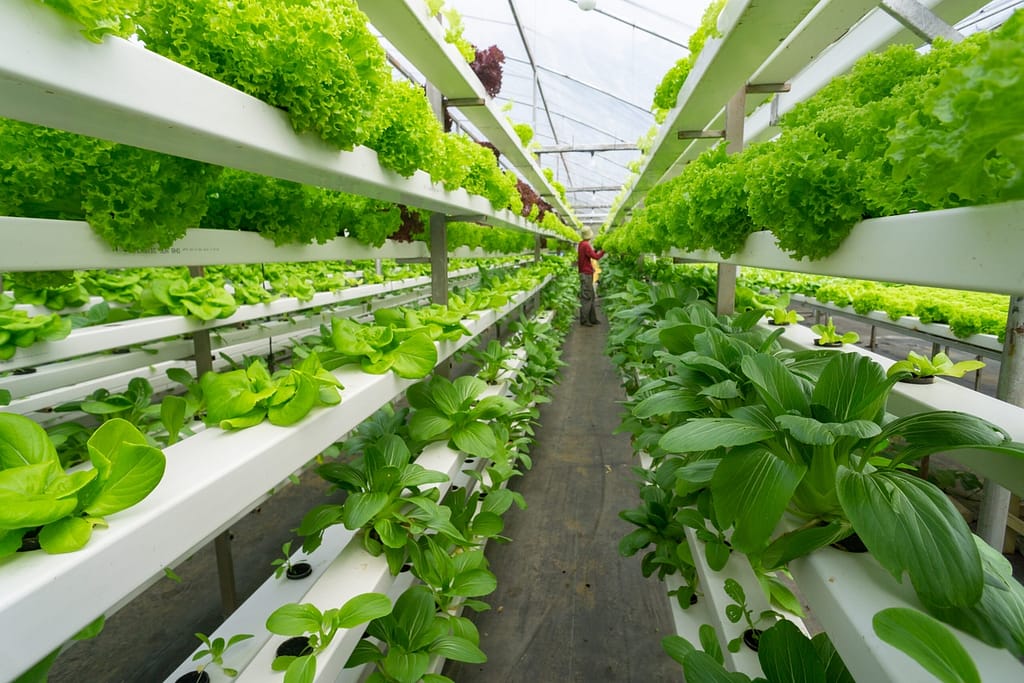
As the sustainability agenda has become more prominent in recent years, vertical farming has grown in popularity due to its highly efficient way of growing food.
For those who don’t know, vertical farming is the practice of growing crops indoors in vertically stacked layers, using controlled environments to optimise crop growth. Instead of natural elements like sun and rain supporting growth, LED lighting, controlled growing and nutrition systems are used instead.
The industry has had very mixed reviews of vertical farming – with some reporting that the process is dying off and others believing it’s thriving. But just what are the benefits and drawbacks? And what is the future of vertical farming?
Supermarket support
UK supermarkets have been known to show their support for vertical farming, with more products grown in this way consistently being seen in stores and online. For example, Tesco, Iceland and Asda all stock vertically farmed salad. GrowUp Farms launched its bagged salad brand into Iceland earlier in the year, whilst Ocado-backed vertical farmer, Jones Food Company, has its salad brand, Homegrown, stocked in 270 Asda stores and online.
Moves like this are very beneficial to the vertical farming industry because, if sale figures are successful, supermarkets are likely to continue the move towards more vertically farmed produce. And it’s not just the farmers that benefit – consumers do too. Because the crops are grown in nutrient-enriched water, vertical farms can spend more time enhancing the nutritional value of them, meaning that consumers are eating a healthier product.
Sustainable values
In 2020, the UK agriculture industry accounted for 69% of nitrous oxide emissions, 48% of methane, and 1.7% of carbon dioxide. With this in mind, vertical farming offers an alternative solution to help combat the environmental impacts of traditional farming.
Compared to traditional methods, vertical farms produce fewer greenhouse gases, use less land, less water and allow for a greater diversification of crops. What’s more, the technique allows carbon emissions to be lowered through reduced food miles and reduced use of fertilisers, which can pollute nearby land and rivers.
Although there has been criticism over the years surrounding the energy use of vertical farms, there are many opportunities to run them on renewable energy sources such as wind or solar power, and research is being done to allow the increased use of this.
What’s going wrong?
Despite all the benefits of vertical farming, there is evidence that the industry is beginning to slow. There have been reports of many businesses closing down, with AeroFarms, App Harvest, Kalera and Future Crops all filing for bankruptcy, whilst others have ended operations.
Looking at the wider picture, at least 15 vertical farms across Europe have gone bankrupt, called in administrators or are out of business. And even those with supermarket backing are struggling – InFarm, which opened one of the largest vertical farming facilities in Europe in June 2022 and was supplying herbs and other produce to M&S, has initiated layoffs and relocated away from Europe.
On top this, the rising cost of energy prices is also an issue, as vertical farms need constant power to keep them running and to ensure crops are looked after. With energy prices being so volatile, it’s no surprise that many companies have been forced into closure.
It seems that vertical farming is yet to be proven in the long-term. However, with the climate crisis consistently worsening, we will continue to see a need for greener alternatives and vertical farming may well prove a solution.
Do you own a hospitality business and source your produce from a vertical farm? Or is this something you’re looking into? If so, we’d love to hear from you!
